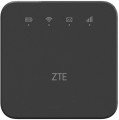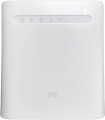Wi-Fi
Wi-Fi connection speeds, more precisely, Wi-Fi standards supported by a modem with the appropriate capabilities (see "Type", "Connection").
— Wi-Fi 3 (802.11g). A further development of the Wi-Fi 1 (802.11b) standard, developed primarily for increasing connection bandwidth (2.4 GHz) and introduced in 2003. 802.11g hardware is fully backwards compatible with 802.11b, so even the simplest of today's Wi-Fi devices support both of these standards.
— Wi-Fi 4 (802.11n). The Wi-Fi standard, which is a further development of the formats described above — in particular, by supplementing them with support of MIMO technology (distribution of input and output between several antennas). Introduced in 2009. The main operating frequency is 2.4 GHz, but there are devices supplemented with a 5 GHz band.
—
Wi-Fi 5 (802.11ac). Built on top of 802.11n, introduced late 2013. The main improvements were the increase in the number of streams at the second frequency (5 GHz) and the introduction of more advanced MIMO and modulation standards, which increased the throughput accordingly.
Connected devices, up to
The largest number of devices that can be simultaneously connected to the modem via Wi-Fi (see "Connection").
The presence of this limitation is due to the fact that processing network requests from several devices at once requires a fairly large amount of computing resources, and there are not so many of them in miniature electronics like wireless modems. However, even inexpensive models can support about 5 – 6 devices, which is more than enough for most cases; and in more advanced modems, this number can reach 10.
Effective range
The greatest distance at which the modem's built-in router is capable of providing communication via the Wi-Fi interface (see "Connection").
It should be taken into account that in fact the range strongly depends on a number of factors that are not related to the main specs of the modem: the presence of interference and obstacles in the signal path, the specs of the Wi-Fi module of the connected device, the battery charge in this device or the modem itself, etc. Therefore, the actual range indicators can be noticeably lower than the claimed ones: for example, when working through a wall, they are noticeably reduced. However, this spec quite clearly describes the overall range of the device, and comparisons of different models on it are quite acceptable.
Also note that it does not always make sense to purchase a device with a maximum range — although a long range provides additional convenience, it requires high transmitter power, which significantly increases the size and price of the modem. Therefore, when choosing, it is worth proceeding primarily from the intended scenarios of use. For example, if you need a 3G connection to access the Internet on the road from your tablet, a range of several metres will be enough. But for installation in a large private house, it makes sense to look for a model with increased effective range.
4G (LTE)
The 4G (LTE) mobile connection speed supported by the modem.
All modern LTE equipment is assigned one or another category (
Cat.3,
Cat.4,
Cat.6,
Cat.7,
Cat.9,
Cat.12,
Cat.13,
Cat.16,
Cat.18,
Cat.19,
Cat.20,
Cat.22), on which the transmission speed directly depends. This paragraph specifies both this category and specific speed indicators, moreover, in two parameters — for reception and for transmission. The transmission speed is always much lower, but given the specifics of mobile Internet access, this is usually not critical.
Note that equipment with different speed categories will be quite compatible with each other, however, the throughput will be limited by the capabilities of the slower device. It is also worth saying that this paragraph indicates the theoretical maximum; practical amounts can be noticeably lower (depending on the quality of the network coverage and the features of specific electronics). However, a modem with a higher speed category will perform faster in fact.
Ports
—
USB plug. The presence in the design of the modem of its own USB plug, which allows you to connect the device to a computer directly. Such a connection provides a device with a USB port with Internet access, and the power necessary for the operation of the modem is also supplied via USB.
—
microUSB. A smaller version of the USB connector (see above), used primarily in Wi-Fi modems (see "Type") that can work autonomously and do not require a constant connection to another device. At the same time, in 3G/
4G modems, microUSB usually looks like a socket, not a plug, and a special cable is used to connect. This interface usually plays the role of a general-purpose service connector: the battery is charged through it, and it is also connected to a PC or other device to manage settings, update firmware, etc.
—
USB. Wired interface, the most common and universal modern standard used to connect peripheral equipment to various electronic devices, ranging from computers to smartphones and even wireless modems. In this case, the full-size version of the USB connector is meant. It is usually installed in classic modems (see "Type") and has the form of a plug, with which the modem is connected to a control device (PC, laptop, tablet, etc.). Power is usually supplied through the same connector.
—
...>USB-C. Connector, in its functional features similar to the paragraph above. With the exception of the symmetrical form factor and the use of more modern technologies.
—
LAN (RJ45). Classic wired connection via a cable with an RJ-45 connector. Also known as "LAN". Nowadays, it is one of the most common methods of wired Internet connection, and is also widely used in local networks. With it, you can connect a laptop or PC directly to the modem via a cable and not bother with a Wi-Fi connection. In addition, such a connection can be faster (depending on the speed of the LAN).
— ExpressCard. A connection interface mainly used in laptops. Peripheral devices of this standard, including wireless modems, have the form of cards, when connected, they are installed in a special slot in the device. It should be taken into account that there are two ExpressCard form factors — 54 mm and 34 mm, and 34 mm cards can be used without restrictions with 54 mm slots, but not vice versa. Therefore, when choosing such a modem, it is worth clarifying the correspondence of its form factor to the planned slot. However, this standard is gradually disappearing from the scene, being replaced by more advanced interfaces — in particular, USB 3.0.
R-UIM card slot
The presence
of a slot for an R-UIM card in the modem design. The purpose of such cards is similar to the SIM cards described above, but they are used in networks based on CDMA (and, accordingly, in modems with EV-DO support, see "Transmission Technologies"). Note that, unlike devices for GSM and UMTS networks, for CDMA modems a slot for this type of card is not a mandatory element of equipment — many such devices are tied to the network by changing the firmware, which is why operators of such communication may not use R-UIM at all. Therefore, although in general the use of cards is simpler and more convenient for the user than flashing, however, the choice of the presence or absence of an R-UIM slot depends on the requirements of the network with which the modem is planned to be used.
Battery capacity
The capacity of the battery installed in the modem with the corresponding type of power supply (see below).
The higher the capacity, the longer the battery is able to work without recharging, all other things being equal. However, note that the situation of "other things being equal" is almost not found in modern wireless modems. First, different data transmission technologies (see above) have different power consumption; secondly, even models supporting the same standards can differ in power consumption (and battery life) due to design differences. Therefore, this indicator in most cases is purely reference information, and even very similar models can only be compared approximately. When choosing, it is worth focusing primarily on the claimed specs of the battery life (see below).
Operating time (internet browsing)
The maximum operating time of the modem with battery power (see "Power") on a single charge in Internet browsing mode. Such power is typical for Wi-Fi routers, therefore, usually, Internet browsing is supposed to provide access to the World Wide Web for an external Wi-Fi device.
This spec is the main indicator of battery life for any battery-powered modem, because it describes the time of using it for its main purpose without recharging. At the same time, you should know that this indicator is measured under certain "perfect" conditions; the actual operating time depends on a number of factors, including the intensity of browsing, the amount of data transferred, the number of connected devices and the distance to them, the cellular network signal strength, etc. Therefore, in fact, the battery life of the modem may be somewhat lower. Nevertheless, it is quite possible to compare different models with each other according to the operating time stated in the specs.
Operating time (standby)
The maximum time the modem can operate on battery power (see "Power") in standby mode on a single battery charge.
This mode can be described as the standby mode. It assumes that the device is turned on, its operating circuits are powered and ready to respond to an incoming signal or user command at any time, but no data exchange occurs and no features work. This indicator is not as important as the Internet browsing time (see above), but it is also of practical importance and allows you to evaluate the battery life of the device — after all, during breaks between communication sessions, the modem is in standby mode.

